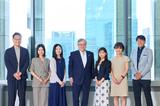* This article is as of writing in March 2021
Click here for "【Part 1】 15 Years of Hitachi’s Internal Employee Network"
Click here for "【Part 2】 The Logic of Transforming an Organization"
Click here for "【Part 3】 Making a Fresh Start from Stagnation"
Click here for "【Part 4】 Challenging the Pandemic by DX of Innovation"
Click here for "【Part 5】 Secret behind the Longevity of Team Sunrise"
Click here for "【Part 6】 Drivers of Innovation"
Click here for "【Part 7】 The Man Who Brought the US Bestseller “The Human Element” to Japan"
Click here for "【Part 8】 Global Mindset and English"
Click here for "【Part 9】 Organization Where Innovation Occurs from the Bottom Up"
Growing Out of the Use of Negative Terms like "Big Company Syndrome" and "Young Talents Can't Thrive"
The Global Wakate-kai, which began with just around 10 people in 2006, expanded to 500 members within five years of its establishment. Cross-organizational communication accelerated during this period. However, a negative trend started to emerge. Masahiko Sato reflects on this time:
"The terms 'big company syndrome' and 'young talents can't thrive' began to surface more frequently as themes in our study sessions. While these topics resonated well with the media and the masses, it seemed like we were increasingly focused on exploring the negatives brought about by organizational bureaucratization and sectionalism, as well as listing reasons why fewer attentions were paid to young talents at Hitachi. Moreover, no concrete solutions emerge from discussions on such topics as interpretations varied among individuals. Gradually, it felt like the entire community was slipping into a state of stagnation.
At that time, senior colleagues would mention that movements like this, centered around young talents, had come and gone every few years for decades. Knowing this, I wanted to transform the study group to become a mechanism and culture that genuinely contributes to the company."
With negative words circulating, individuals with negative thoughts tended to gather. Frustrated with this situation, some members chose to leave the group. Why do people fall into negative thinking in the first place? Sato once again attempted to analyze this, drawing from insights gained in graduate school.
"The Cycle of Confirmation Bias" Leading a Community into Stagnation
Sato relied on the "Prospect Theory," primarily utilized in the field of behavioral economics.

Figure based on Kenshu Kikuzawa’s “Introduction to Organizational Economics”
According to this theory, people tend to find dissatisfaction from failures more significant than the psychological satisfaction gained from success. Furthermore, the joy from repeated success doesn't increase substantially, while the feelings of dissatisfaction from repeated failures don't intensify much either; instead, they tend to numb. Comparing this to investor behavior, when profits are present, there's a tendency to avoid risks until those profits are deemed sufficient. On the other hand, even in the face of losses, there's a tendency to continue investing. In essence, when there are profits, individuals tend to adopt risk-averse behavior, but when losses occur, they pursue risks. Sato applied this theory to community and network activities and illustrated it as follows:

"My hypothesis is this: the cycles that push community or network activities into stagnation stem from two types of bias, arising from a view through 'color lenses' of participating individuals’ mindset. One of them is the 'Yes-Man Cycle.' When the degree of bias through the colored lens of efficiency, emphasizing not doing unnecessary things, becomes excessive, it leads to a passive attitude of waiting for instructions. By accumulating safe success experiences, you may be able to avoid criticism, but you may end up just maintaining the status quo. When told to do something new, you may feel 'being forced'; the resulting action may become rather ceremonial or formalistic.
The other is the "Outlaw Cycle." Relying on popular yet negative keywords such as 'Big company syndrome' or 'Young talents can't thrive,' and repeatedly making radical statements or engaging in risky behavior through (the lens of) a distorted sense of justice can create initial excitement. However, as the behavior escalates, it eventually results in isolation without understanding from others. Neither of these biases can lead to creating something new. I call this phenomenon the 'color lens cycle' driven by confirmation bias."
Sato found confidence in this conclusion later through the book "Why Do the World's Elites Train their 'Aesthetics'?" by Shu Yamaguchi. The book contains the following passage: "Only those who adapt to the system can modify the system (i.e., the elites). …Critically relativize systems that provide various benefits without being deceived by those benefits. This is precisely the intellectual attitude required of elites living in the 21st century" (partially edited).
"To change an organization, you need individuals trusted by that organization. However, these individuals are prone to becoming Yes-Men as they benefit from the organization. That's why it's essential to refine aesthetic sensibility and cultivate the power to change the organization. - That's how I interpreted it. In essence, it's not a binary choice between being a Yes-Man or an Outlaw; the balance between the two is crucial. If you feel your mind is tinted with the Yes-Man lens, ask yourself, 'Am I taking a step into something new?' If you sense your mind is colored with the Outlaw lens, realize that you need to think, 'Am I making the people around me happy?'"

Shu Yamaguchi (left), Kenshu Kikuzawa (center), and Sato
"Team Sunrise," Supporting the Shoots of Innovation
Sato redefined the purpose of the group’s activity: "Let's create new businesses at Hitachi." Simultaneously, to shift the focus of the activity towards finding the positive aspects of Hitachi, he began to explore grounded operating methods. Just at that juncture, in 2015, a proposal submitted by the Global Wakate-kai won an award at Hitachi's inaugural internal business idea contest, "Make a Difference!" It was selected as one of only five finalists from over 600 submissions worldwide.

A photo from the award ceremony of Hitachi’s “Make a Difference!” business idea contest in 2015. Toshiaki Higashihara, then CEO of Hitachi, Ltd. (center) and members of Team Sunrise
This brought a sudden surge in attention to the Global Wakate-kai. Capitalizing on the ongoing renewal of its activities, Sato and other members rebranded it as "Team Sunrise" in 2016, marking a fresh start. "Sunrise" represents the rising sun, symbolizing Hitachi. Likening an organization (with execution capability) to a mountain, which incurs "transaction costs" (as mentioned in Part 2), the activity of Team Sunrise is positioned like the sun rising. It serves as an "opportunity for connections with an indirect organizational relation" where people connect beyond positions and generations, illuminating Hitachi's colleagues. The symbol of the activity is the bamboo shoot (Takenoko). It encapsulates the strong desire of Sato and his team to cherish a "culture of support."

Sato, along with other members, designed the Team Sunrise logo (right) based on the idea of Team Sunrise activities (left)
"Bamboo shoots supposedly grow vigorously in places not easily seen by people. In reality, their roots spread like a network in the soil, and when they find a spot, they pop up above ground. Like bamboo shoots, there are likely many people within Hitachi's organization holding ideas for future businesses, unable to consult with anyone. In a way, I want to shine a light on the 'innovation bamboo shoots' and nurture them. To achieve this, we not only want people to come for advice with their ideas but also simultaneously increase the number of supporters. That is the focal point of Team Sunrise's activities."
It's not just for a select few keen employees but a place where individuals, irrespective of their organization, generation, or position, can easily participate without necessarily having groundbreaking ideas. Changing the activity's approach significantly lowered the barrier to participating in study sessions, attracting people once again. In 2017, the registered members of Team Sunrise finally reached 1,000.
Click here for "【Part 4】 Challenging the Pandemic by DX of Innovation"
CASE STUDY

Kazumasa Ishikawa at Hitachi Systems, Ltd.
“I joined the former Hitachi Electronic Services Co., Ltd. (now Hitachi Systems, Ltd.) after graduating from high school in 2006. I initially worked as a customer engineer handling system maintenance, and I was later transferred to the business planning department. I’ve been involved in M&A activities with overseas companies, assigned to Silicon Valley office, and currently back in Business Planning. I’ve been a member of Team Sunrise since 2009 when it was still Global Wakate-kai.
The catalyst for my career shift from a customer engineer was a post I left on Hitachi Group's internal social media site, "COMOREVY." Around 2009, as public clouds like AWS was gaining attention, I expressed my view that, as most systems would transition to the cloud, the traditional structure of systems and the maintenance of IT devices would become less common, while increasingly in demand would be maintenance services that are capable of handling various devices in addition to IT devices. This led to a recommendation by someone at management planning department of a group company to Hitachi Systems, which had been seeking for talents in global strategy, ultimately resulting in the move to business planning.
Utilizing Team Sunrise's network, I’ve collaborated with members of group companies to propose communication services to customers. Also, I contributed to my company’s planning and organizing of events for recovery from the Great East Japan Earthquake in collaboration with a space development project team in which I was personally involved.
I’m currently involved in expanding business to international markets, while enrolled in a business administration course at a correspondence university. I’m considering pursuing an MBA to further enhance existing expertise and aims to contribute my skills and ideas to society in a manner that is suitable to the times.”

Masahiko Sato
Before joining Hitachi, Ltd. in 2001, he worked at non-governmental organization as system engineer. He earned MBA while working for system engineering of information & telecommunication, incorporation of a company, and M&A projects. He also worked at IT Strategy Division at Hitachi Headquarters and currently works at Global Center for Social Innovation at R&D Group as Chief Researcher. Head of Team Sunrise (formerly known as Global Wakate-kai founded in 2006), a network of employees across Hitachi. Currently enrolled at Doctoral Degree Program at Tokyo Institute of Technology in Innovation Science. *
* As of the writing of this article
シリーズ紹介
楠木建の「EFOビジネスレビュー」
一橋ビジネススクール一橋ビジネススクールPDS寄付講座特任教授の楠木建氏の思考の一端を、切れ味鋭い論理を、毎週月曜日に配信。
山口周の「経営の足元を築くリベラルアーツ」
山口周氏をナビゲーターに迎え、経営者・リーダーが、自身の価値基準を持つための「リベラルアーツ」について考える。
協創の森から
社会課題の解決に向けたビジョンの共有を図る研究開発拠点『協創の森』。ここから発信される対話に耳を傾けてください。
新たな企業経営のかたち
パーパス、CSV、ESG、カスタマーサクセス、M&A、ブロックチェーン、アジャイルなど、経営戦略のキーワードをテーマに取り上げ、第一人者に話を聞く。
Key Leader's Voice
各界のビジネスリーダーに未来を創造する戦略を聞く。
経営戦略としての「働き方改革」
今後企業が持続的に成長していくために経営戦略として取り組むべき「働き方改革」。その本質に迫る。
ニューリーダーが開拓する新しい未来
新たな価値創造に挑む気鋭のニューリーダーに、その原動力と開拓する新しい未来を聞く。
日本発の経営戦略「J-CSV」の可能性
日本的経営の良さを活かしながら利益を生み出す「J-CSV」。その先進的な取り組みに迫る。
ベンチマーク・ニッポン
日本を元気にするイノベーターの、ビジョンと取り組みに迫る。
デジタル時代のマーケティング戦略
マーケティングにおける「デジタルシフト」を、いかに進めるべきか、第一人者の声や企業事例を紹介する。
私の仕事術
私たちの仕事や働き方の発想を変える、膨らませるヒントに満ちた偉才たちの仕事術を学ぶ。
EFO Salon
さまざまな分野で活躍する方からビジネスや生活における新しい気づきや価値を見出すための話を聞く。
禅のこころ
全生庵七世 平井正修住職に、こころを調え、自己と向き合う『禅のこころ』について話を聞く。
寄稿
八尋俊英の「創造者たち」~次世代ビジネスへの視点~
新世代のイノベーターをゲストに社会課題の解決策や新たな社会価値のつくり方を探る。








